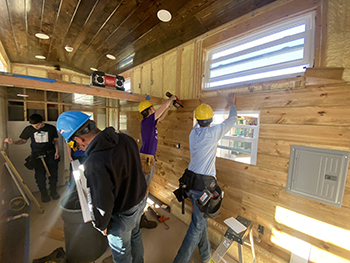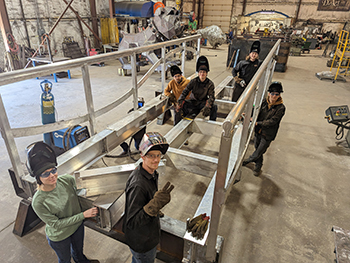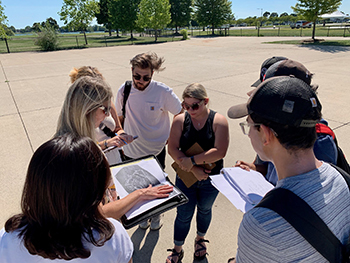Partnerships with educational institutions benefit students, communities, state park visitors
By HEATHER DUROCHER
Trails and resources writer and editor, Parks and Recreation Division
Michigan Department of Natural Resources
More meticulous construction work, it turned out, interested Asher Wise the most: spending hours working on a fuse box, carefully positioning and running electrical wires, securing fixtures in place.
You could call the experience a lightbulb moment for the recent graduate of the building trades program for high school students in Lenawee County.

“Electrical is probably my favorite out of everything,” said Wise, 18, who helped build two tiny homes over the past nine months while taking classes at Lenawee Intermediate School District TECH Center in Adrian.
“I liked the challenge of bringing the homes up to code. There were a couple of times during the construction when a box wasn’t hooked up right and I had to go back and fix it. I don’t mind sitting there for three hours working on a box or moving wires. Knowing it was hooked up right and understanding what gives us electrical power – it’s the best feeling in the world.”
These two student-built tiny homes are more than an important hands-on learning opportunity for Wise and his building trades program classmates – they’re also part of a newer partnership between the Michigan Department of Natural Resources and the TECH Center that ultimately adds more camper lodging options at nearby W.J. Hayes State Park in Onsted.
“It’s been a really good, positive experience,” said Shane Morse, park supervisor, adding he’s happy to also be able to give seasonal jobs to a handful of these students. “That was one of my big pushes for this partnership – they’re building tiny homes and they’re also getting connected; it’s opening their eyes to what we as a division offer for employment.
“When you’re pulling students from a class like Asher’s, the experience they’ve gotten in these classes helps tremendously when they’re walking into a park. They’re ready to go out in the field.”
Partnerships between the DNR and student programs across the state aren’t new, but they are growing, particularly within the Parks and Recreation Division, where such collaborations provide hands-on, real-world experience to youth while assisting the DNR in important ways that positively impact communities throughout Michigan.
“These experience-based partnerships help inform our management efforts while making parks and associated programs relevant to future generations,” said DNR Parks and Recreation Chief Ron Olson.
From tiny home construction to bridge building to dreaming big about the future of state parks, cultural and historic resources – and numerous other ways student input is helping shape ideas for state-managed places and spaces – a variety of projects are underway that involve students of all ages.
Improved pathways
Campers and visitors at Harrisville State Park in Alcona County will soon be able to explore the 107-acre park along the shore of Lake Huron more easily, thanks to a group of welding students from Industrial Arts Institute in Onaway.
|

Students recently helped build a pathway that will connect the park’s day-use area and campground. The footbridge, expected to be installed this summer, will improve accessibility for visitors as well as give park staff a more efficient way of getting around the property off U.S. Route 23 in Harrisville.
“On behalf of Harrisville State Park, we were extremely excited to be able to work with the Industrial Arts Institute to help make this project a learning experience for the students,” said Eric Ostrander, park supervisor for Harrisville and Negwegon state parks on the east side of the state’s Lower Peninsula. “This will be a great story to tell for years to come once our users see the beautiful creation they were able to make.”
Tamara Ward, executive director of the Industrial Arts Institute, said this project – the second such effort for the DNR Parks and Recreation Division – aligned with several of the school’s educational objectives.
“Our students get hired for their great welding skills,” Ward said. “But they have great careers because we help them build a solid work ethic, a focus on quality workmanship and a sense of civic responsibility.”
|

Projects like constructing the footbridge help students understand all the ways they can deliver value as a future employee.
“We feel that supporting an organization like the IAI is beneficial because the skilled trades are very important to us, as we need those kinds of people to help keep up and maintain our parks,” Ostrander said.
This partnership helps the DNR bring projects to life that may not get done otherwise, added Richard Hill, Gaylord District supervisor for the Parks and Recreation Division.
“With our backlog of infrastructure needs, these projects are sometimes a struggle to get to because they’re larger in scale than what we can tackle at a district level,” said Hill, who shared the DNR’s gratitude for this creative partnership when he spoke to students during their recent graduation ceremony.
The DNR and Industrial Arts Institute previously collaborated on a project that involved constructing trail gates. Future projects under consideration include fireplaces, fee pipes, welcome signs and interpretive panels. Through these efforts, the students and the DNR aim to create positive experiences for visitors to public lands.
“Students have been a part of creating DNR projects such as the gates for the state trails and footbridges for state parks since early 2021,” Ward said. “This partnership has allowed IAI to train our welders and fabricators with real-world projects and provides an opportunity for our students to use their skills to bring value to the communities they live and play in.”
The institute also collaborates with the DNR on corporate upskilling, providing training for department staff seeking continuing education.
Dreaming big
Developing schematic master plans for the Belle Isle Park paddock area and Hammond Bay State Harbor and creating a construction package for Warren Dunes State Park all were tasks students took on as part of this year’s partnership between the DNR and the Michigan State University’s School of Planning, Design and Construction.
|

The partnership is more than a decade old, providing students with the opportunity to visit sites across the state and pitch ideas for reimagining what each place could be to its community and visitors.
“It’s been really cool to think through problems and come up with different solutions,” said Jordan White, a senior in the MSU landscape architecture program taking part in this partnership, known as the Sustainable Park Design and Planning Project. “It’s really cool to see the project and to dream big.”
Each year, students consider design possibilities and create proposals for select parks, said Jun-Hyun Kim, Ph.D., associate professor and program director of the landscape architecture program in the MSU School of Planning, Design and Construction.
The goal, in cooperation with DNR staff, is to analyze current conditions and assess accessibility and universal design features, as well as sustainability and green building features. The students also tackle site design and planning and historic preservation, ultimately providing recommendations or guidelines for future renovation and/or development of the project area.
“It’s quite impactful,” Kim said of the opportunity students have for taking a project from design concept through discussions with DNR and community members to final design presentation.
The expertise shared by DNR staff is invaluable to the process, he added: “The important part is the context and the characteristics of the project. The students are engaged from beginning to end.”
|

At Warren Dunes State Park – known as the unofficial gateway to Michigan’s state park system from the west – students were asked to develop a new trail system design plan. This park, located in Sawyer, is home to 3 miles of shoreline, 6 miles of hiking trails and two popular campgrounds.
Students visited in November of last year, traveling the length of the proposed trail and visiting other areas of the park to inform their design plans. This project was especially meaningful for Nick Gattoni, a junior in the MSU landscape architecture program.
“The DNR will actually take a look [at implementing changes] based on our construction document,” Gattoni said of the work he and his classmates did in identifying places for a trailhead, where sculptures could reside, how the trail could connect with the campground and other considerations. “We will have a big part in how those are actually put in.”
Gattoni is interested in pursuing a career in landscape architecture.
“I want to go into parks and recreation, so this is right up my alley,” he said. “It’s neat to me, being outside and seeing people interact with the landscape, figuring out how to brighten their days and benefit their lives.”
Tiny homes, big impact
The two W.J. Hayes State Park tiny homes – the first full-amenity tiny homes in the park – arrived this week, said Morse, who was instrumental in creating the partnership after learning the TECH Center began offering students the chance to build tiny homes in the past couple of years.
|

The tiny homes have kitchenettes, including a full refrigerator and cabinets. “They’re pretty well tricked out,” Morse said.
The students learned how to meet accessibility standards throughout the building process. They also went through the process of having the tiny houses certified by the National Organization of Alternative Housing with help from instructor David Hillard.
These inspections are performed and/or reviewed by certified professional inspectors, engineers, general contractors, electricians, plumbers and other professionals, Morse said.
“This is a voluntary program for builders to demonstrate compliance with safety, structural and energy efficiency standards,” he said. “This was an important aspect for David to teach to his students as he prepared them for their professional careers. He is a vital part of the partnership – he puts a lot of work and effort into his students, class and this partnership.”
|

For Wise, whose summer employment at Hayes State Park will end in August when he heads off to Williams College of the Trades outside Philadelphia, where he will study to become an electrician, the tiny home project is one he won’t soon forget. He’s happy to be part of not only building the structures, but also getting them ready for campers.
“It was a long process, but it was worth it,” Wise said. “I am just excited to get these tiny houses in place.”
The project reach goes well beyond student builders, park staff and campers, Morse said. Community members also are learning about the partnership and recognizing the value of having these tiny homes built by students for their own local state park.
“Being the first year, we’ve realized we have a million different directions we could go with this partnership – lots of ideas are being brainstormed,” he said. “It’s just going to grow.”
|
Check out previous Showcasing the DNR stories in our archive at Michigan.gov/DNRStories. To subscribe to upcoming Showcasing articles, sign up for free email delivery at Michigan.gov/DNREmail.
Note to editors: Contact: John Pepin, Showcasing the DNR series editor, 906-226-1352. Accompanying photos and a text-only version of this story are available below for download. Caption information follows. Credit Michigan Department of Natural Resources, unless otherwise noted.
Text-only version of this story.
Building: Students at Lenawee Intermediate School District TECH Center in Adrian spent the past nine months building two tiny homes that recently were delivered to nearby W. J. Hayes State Park in Onsted.
Communities: Industrial Arts Institute student welders and fabricators are helping the Michigan Department of Natural Resources by completing much-needed projects that positively impact communities.
Connections: Industrial Arts Institute students put their stellar welding skills to work while creating a footbridge for Harrisville State Park.
Experience: Industrial Arts Institute student welders and fabricators work on the footbridge that is expected to be installed this summer.
Home: One of two tiny homes that students at Lenawee Intermediate School District TECH Center in Adrian recently built at W. J. Hayes State Park in Onsted.
Interior: TECH Center students work on the interior of one of the tiny homes.
MSU students_1: The Sustainable Park Design and Planning Project gave students in Michigan State University’s School of Planning, Design and Construction the chance to visit state parks and provide design enhancement ideas to the Michigan Department of Natural Resources.
MSU students_2: Michigan State University students review state park plans as part of their site visit to Belle Isle Park.
|